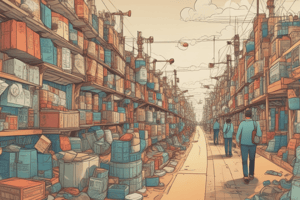Podcast
Questions and Answers
Which of the following is NOT a characteristic of a market economy?
Which of the following is NOT a characteristic of a market economy?
Which of the following economic systems aims to allocate resources based on government control?
Which of the following economic systems aims to allocate resources based on government control?
Which of the following is NOT a basic economic question?
Which of the following is NOT a basic economic question?
What does the concept of 'marginal analysis' suggest?
What does the concept of 'marginal analysis' suggest?
Signup and view all the answers
Which of the following is a key factor that contributes to higher long-term economic growth?
Which of the following is a key factor that contributes to higher long-term economic growth?
Signup and view all the answers
Microeconomics focuses on:
Microeconomics focuses on:
Signup and view all the answers
Which economic concept assumes that all other factors remain unchanged when analyzing a specific variable?
Which economic concept assumes that all other factors remain unchanged when analyzing a specific variable?
Signup and view all the answers
What is the primary reason why a point inside the production possibilities frontier (PPF) represents an inefficient use of resources?
What is the primary reason why a point inside the production possibilities frontier (PPF) represents an inefficient use of resources?
Signup and view all the answers
What is the best example of a normative economic statement?
What is the best example of a normative economic statement?
Signup and view all the answers
Which of the following is a characteristic of the Production Possibility Frontier (PPF)?
Which of the following is a characteristic of the Production Possibility Frontier (PPF)?
Signup and view all the answers
Which of the following would cause an outward shift in the Production Possibility Frontier (PPF)?
Which of the following would cause an outward shift in the Production Possibility Frontier (PPF)?
Signup and view all the answers
What is the opportunity cost of choosing to produce more consumer goods?
What is the opportunity cost of choosing to produce more consumer goods?
Signup and view all the answers
Which of the following best describes a 'human resource' in economics?
Which of the following best describes a 'human resource' in economics?
Signup and view all the answers
Study Notes
The Economic Problem
- Scarcity exists because resources are limited but wants are unlimited.
- Economics studies how resources are allocated to satisfy wants.
The Three Basic Economic Questions
- What to produce? This considers the types of goods and services to make, including consumer goods, capital goods, essentials, and luxuries.
- How to produce? This involves the resources used in production, such as natural resources (land, water, minerals, climate), labor, and capital (tools, factories).
- For whom to produce? This concerns how goods and services are distributed and whether all groups have equal access.
Types of Resources
- Natural resources: Land, water, minerals, and climate.
- Human resources: Labor, which includes the physical and mental effort of workers.
- Enterprise: The ability to organize and manage resources to produce goods and services.
- Capital resources: Man-made tools, machinery, factories, transport used in production.
Microeconomics vs. Macroeconomics
- Microeconomics: Focuses on small-scale issues like individuals, businesses, and markets, studying consumer and producer decisions and market price allocation.
- Macroeconomics: Analyzes large-scale issues like the entire economy, encompassing total production, employment, and price levels, economic growth, and business cycles.
Key Economic Concepts
- Economic Model: A simplified representation of reality showing economic relationships.
- Ceteris Paribus: A Latin phrase meaning "all other things remaining the same," used in analysis to isolate variables.
- Opportunity Cost: The value of the next best alternative that is forgone when a choice is made.
- Example: Choosing an Apple product over a Samsung one means giving up the benefits of the Samsung product.
- Positive Economics: Based on facts and data, answering "what is?".
- Example: A tax on pollution will reduce pollution.
- Normative Economics: Based on opinions and values, answering "what should be?".
- Example: The government should increase taxes on the rich.
Production Possibility Frontier (PPF)
- Represents the maximum output of an economy with fixed resources and technology.
- Shows trade-offs, scarcity, and opportunity cost.
- Outward shift: Economic growth (more resources, better technology).
- Inward shift: Economic decline (loss of resources, war, disaster).
Economic Growth & Investment
- Higher investment leads to higher long-term economic growth.
Economic Systems
- Market Economy (Capitalism): Private ownership, prices determined by supply and demand.
- Planned Economy (Socialism/Communism): Government control over production and distribution.
- Mixed Economy: A combination of market and government intervention.
Marginal Analysis
- Economic decisions are based on comparing marginal benefits (MB) and marginal costs (MC).
- Resource allocation continues until MB = MC.
Review Questions
- Scarcity: Unlimited wants exceed limited resources.
- Economic good: A scarce good (not free).
- Reward for risk-taking: Profit.
- Inefficiency (PPF): Resources are underutilized; more production possible.
- Mixed economy feature: Both private and public sector involvement.
Studying That Suits You
Use AI to generate personalized quizzes and flashcards to suit your learning preferences.
Description
Test your understanding of fundamental economic concepts such as scarcity, resource allocation, and the three basic economic questions. This quiz will cover the types of resources and their roles in production and distribution. Perfect for students looking to reinforce their economic knowledge.




